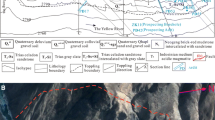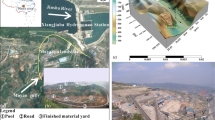Abstract
The objective of the paper is to investigate the initiation of the Jiweishan landslide by simulating the field geological conditions around and inside a selected critical rock block and then to study its stability through 3-D discontinuum stress analysis. The study led to the following main conclusions: (1) The mining excavations that occurred underneath the investigated block at the landslide site, the friction angle of T2 discontinuities and sliding plane and the dip angle of the sliding plane seem to be the most important factors with respect to the instability of the investigated block; (2) It seems that the friction angle of T2 discontinuities and sliding plane need to drop to a value between 5° and 10° for the investigated block to be unstable. This means that the rainfall and karstification have played important roles in reducing the said friction angle and contributed to the failure of the investigated block. (3) The northern part of the investigated block (key block) had moved out first from the top of the mountain in a direction parallel to the strike of the north boundary discontinuity plane (T2) and had undergone shear failure on the T2 surface as well as on a weak shale layer (the sliding plane) and the remaining part of the investigated block (driving block) had moved along a direction slightly east of the north direction and had undergone shear failure on the sliding plane and separation from southern and western boundary discontinuity planes (T0 and T1) to fill the empty space created by the key block to initiate the Jiweishan landslide.





















Similar content being viewed by others
References
Cundall PA (1971) A computer model for simulating progressive larger-scale movements in blocky rock system. Proc Int Symp Rock Fract 2:129–136
Cundall PA (1988) Formulation of a three-dimensional distinct element model-Part 1. A scheme to detect and represent contacts in a system composed of many polyhedral blocks. Int J Rock Mech Min Sci Geomech Abstr 25:107–116
Feng Z, Yin YP, Li B, Yan JK (2012a) Centrifuge modeling of apparent dip slide from oblique thick bedding rock landslide. Chin J Rock Mech Eng 31(5):890–897
Feng Z, Yin YP, Li B, Zhang M (2012b) Mechanism analysis of apparent dip landslide of Jiweishan in Wulong, Chongqing. Rock Soil Mech 33(9):2704–2712
Hart R, Cundall PA, Lemos J (1988) Foundation of a three dimensional distinct element model-Part II. Mechanical calculations for motion and interaction of a system composed of many polyhedral blocks. Int J Rock Mech Min Sci Geomech Abstr 25:117–126
Hou HG, Wang YM (1985) Orthogonal testing method. Jilin People’s Publishing House, Changchun
Itasca Consulting Group, Inc. (2007) 3DEC—3 dimensional distinct element code. Version 4.1
Kulatilake PHSW, Wu TH (1984) Estimation of mean trace length of discontinuities. Rock Mech Rock Eng 17:215–232
Kulatilake PHSW, Ucpirti H, Wang S, Radberg G, Stephansson O (1992) Use of the Distinct Element Method to perform stress analysis in rock with non-persistent joints and to study the effect of joint geometry parameters on the strength and deformability of rock masses. Rock Mech Rock Eng 25(4):253–274
Kulatilake PHSW, Wang S, Stephansson O (1993) Effect of finite size joints on the deformability of jointed rock in three dimensions. Int J Rock Mech Mining Sci Geomech Abstr 30(5):479–501
Lemos JV, Hart RD, Cundall PA (1985) A generalized distinct element program for modeling jointed rock mass. Proceeding of international symposium on fundamentals of rock joints. Bjorkliden, Sweden, pp 335–343
Li TF, Li X, Li SD, He JM, Ma CF (2012) Mechanism of slope failure induced by undermining—a case study of Jiweishan rockslide in Wulong. Chin JRock Mech Eng 31(Supp. 2):3803–3810
Liu WQ (2005) Experiment design. Tsinghua University Press, Beijing
Peng GX (2011) The research of the formative condition and instability mechanism of the landslide controlled by the key blocks in southwest mountainous—cocktail mountain landslide in Chongqing Wulong, for example. Master thesis, Chengdu University of Technology, Chengdu, China
Tang CA (1997) Numerical simulation of progressive rock failure and associated seismicity. Int J Rock Mech Min Sci 34:249–261
Wang X, Kulatilake PHSW, Song WD (2012) Stability investigations around a mine tunnel through three—dimensional discontinuum and continuum stress analyses. Tunn Underg Space Techn 32:98–112
Wu Q, Kulatilake PHSW (2012a) REV and its properties on fracture system and mechanical properties, and an orthotropic constitutive model for a jointed rock mass in a dam site in China. Comp Geotech 43:124–142
Wu Q, Kulatilake PHSW (2012b) Application of equivalent continuum and discontinuum stress analyses in three-dimensions to investigate stability of a rock tunnel in a dam site in China. Comp Geotech 46:48–68
Xu Q, Fan XM, Huang RQ, Yin YP, Hou SS, Dong XJ, Tang MG (2010) A catastrophic rockslide-debris flow in Wulong, Chongqing, China in 2009: background, characterization, and causes. Landslides 7(1):75–87
Yin YP, Sun P, Zhang M, Li B (2011) Mechanism on apparent dip sliding of oblique inclined bedding rockslide at Jiweishan, Chongqing, China. Landslides 8(1):49–65
Acknowledgments
The second author of this paper is grateful to the Chinese Scholarship Council (Grant No. 201206410006) for providing a scholarship to conduct the research as a Visiting Research Student at the University of Arizona.
Author information
Authors and Affiliations
Corresponding author
Rights and permissions
About this article
Cite this article
Kulatilake, P.H.S.W., Ge, Y. Investigation of Stability of the Critical Rock Blocks that Initiated the Jiweishan Landslide in China. Geotech Geol Eng 32, 1291–1315 (2014). https://doi.org/10.1007/s10706-014-9806-z
Received:
Accepted:
Published:
Issue Date:
DOI: https://doi.org/10.1007/s10706-014-9806-z




